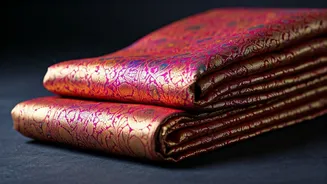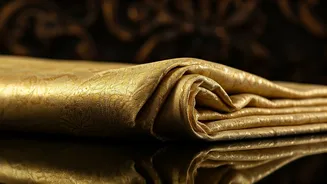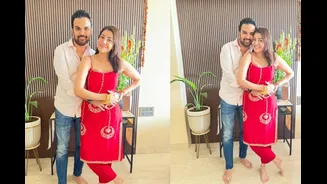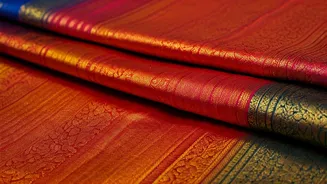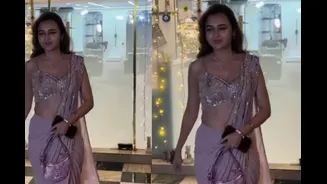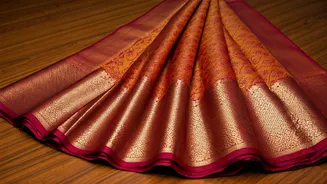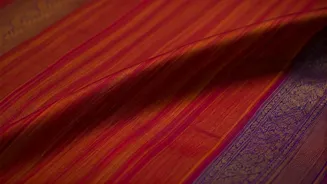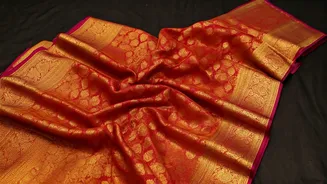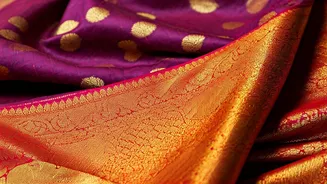Fabric Examination is Key
The fabric is a fundamental aspect of a Banarasi saree's authenticity. Genuine Banarasi sarees are primarily crafted from silk, with the most luxurious
ones using pure silk. The feel of the fabric is significant. Pure silk has a soft, supple texture, in contrast to the stiffness often associated with synthetic materials. Check for the fabric's sheen – silk presents a natural luster, reflecting light beautifully. You can also perform a burn test on a loose thread. Real silk burns with a smell akin to burning hair and leaves ash that can be easily crushed. Synthetic materials, conversely, melt and produce a different odor. Keep in mind the weight; authentic silk sarees generally have a substantial feel because of the density of the silk threads used in weaving. The warp and weft of the fabric should be closely woven, contributing to the fabric's overall quality and longevity. This attention to detail in the fabric ensures the saree is both beautiful and long-lasting.
Weave Style Analysis
The weave of a Banarasi saree is a defining feature, signifying the artistry and craftsmanship involved. Identify the intricate weaving techniques, such as the 'kadwa' or 'kadhua' weave, which involves individually weaving each motif. This method is labor-intensive and results in a raised, textured design on the saree's surface. The 'cutwork' weaving technique is also common, where motifs are cut from the fabric. Examine the motifs closely. Authentic sarees often feature detailed, well-defined patterns with no loose threads or imperfections. A quality weave creates a rich and complex appearance. Another aspect to consider is the design's integration into the fabric. Genuine Banarasi sarees exhibit motifs and patterns that are seamlessly woven into the fabric, rather than simply printed or embroidered. The use of metallic threads, particularly gold or silver zari, is another indicator of quality. Examine the zari work, which should be consistent and well-integrated into the design, adding to the saree's opulence. Understanding the weave style gives you a deeper appreciation for the artistry.
Design Motif Details
The design motifs are integral to the identity of a Banarasi saree, each telling a story. Look for traditional motifs like paisleys, floral patterns (bootis), and geometric designs, which are common in authentic sarees. The intricacy of these motifs reflects the weaver's skill. The motifs should be distinct and precisely executed. The spacing and symmetry of the patterns should be consistent across the saree. Assess the use of colors and the integration of the motifs. Traditional Banarasi sarees often use vibrant colors. The color palette used, along with the patterns' harmony, contributes to the saree's overall appeal. Furthermore, see if the motifs are created using high-quality threads, such as silk or zari. The texture and finish of the threads should complement the overall design. When examining the design motifs, check for any areas where the patterns are blurred or uneven, which could indicate a lower-quality saree. The authentic Banarasi saree will display designs that are intricate, consistent, and beautiful.
Zari and Thread Work
The quality of the zari and threadwork is a critical element in authenticating a Banarasi saree. Genuine sarees often include zari, made from metallic threads, typically gold or silver. Examine the zari closely; it should be smooth, with a consistent finish. Low-quality zari can look dull or tarnish easily. The threadwork is the structure of the pattern and must be of good quality. Authentic Banarasi sarees use high-quality silk threads to create their designs. The threadwork should be neat and well-defined, with no loose threads or unevenness. Assess the density of the threadwork. The more elaborate the design, the more thread is used. Examine the borders and the pallu (the decorative end of the saree). The borders should feature intricate zari work and often include patterns like floral or geometric motifs. The pallu is usually the most ornate part of the saree and will show the weaver's craftsmanship. The integration of zari into the design is crucial. Genuine Banarasi sarees will have zari seamlessly woven into the fabric. The zari threads should be securely attached and should not come loose easily. A close inspection of the zari and threadwork is an essential step in verifying the authenticity of a Banarasi saree.
Check the Price Points
The price of a Banarasi saree is often reflective of its authenticity and quality. Authentic Banarasi sarees are known for their intricate craftsmanship, the use of quality materials, and the time-consuming weaving process. Consider that these sarees are not inexpensive. If the price seems too good to be true, it likely is. Prices can range from moderate to high, varying with factors like the materials used (silk, zari), the complexity of the design, and the weaving technique. The more intricate the design and the higher the quality of the materials, the higher the price. Compare prices from different vendors to get a sense of the average cost for a similar saree. Be aware of the seller's reputation. Purchasing from reputable stores or weavers ensures you're buying a genuine product. Researching the seller's background and verifying their authentication processes is vital. If a saree is significantly cheaper than the typical price for a Banarasi saree, consider it carefully. It may be made with cheaper materials or use less intricate weaving techniques, reducing its authenticity and value. The price is an important factor. Understand the value for the product to make a well-informed decision.
Seek Expert Advice
When purchasing a Banarasi saree, seeking expert advice can be invaluable. Consult with a knowledgeable salesperson or a saree specialist who has extensive experience with these textiles. They can provide insights into the saree's authenticity, weaving techniques, and the quality of materials. An expert can quickly identify authentic features, such as the type of silk, the quality of zari, and the complexity of the motifs. They can also explain the saree's provenance and the history of its design. If possible, consider visiting local weavers or stores specializing in authentic Banarasi sarees. This direct interaction allows you to understand the craftsmanship. If you are shopping online, look for retailers who provide detailed product descriptions and high-quality images. Reputable online stores often offer certificates of authenticity or guarantees. Don't hesitate to ask questions. A knowledgeable seller will be happy to answer your queries and provide additional information to help you make an informed decision. They can highlight the unique characteristics of each saree and help you appreciate the artistry. Expert advice is a crucial element in determining a real Banarasi saree.
